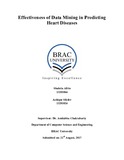| dc.contributor.advisor | Chakrabarty, Dr. Amitabha | |
| dc.contributor.author | Afrin, Shahria | |
| dc.contributor.author | Sikder, Ashique | |
| dc.date.accessioned | 2018-01-04T05:54:24Z | |
| dc.date.available | 2018-01-04T05:54:24Z | |
| dc.date.copyright | 2017 | |
| dc.date.issued | 8/21/2017 | |
| dc.identifier.other | ID 13201066 | |
| dc.identifier.other | ID 13201024 | |
| dc.identifier.uri | http://hdl.handle.net/10361/8915 | |
| dc.description | Cataloged from PDF version of thesis report. | |
| dc.description | Includes bibliographical references (page 30-31). | |
| dc.description | This thesis report is submitted in partial fulfillment of the requirements for the degree of Bachelor of Science in Computer Science and Engineering, 2017. | en_US |
| dc.description.abstract | Heart Diseases affect a large population in today’s world, where the lifestyle is moved from active to comfort-oriented. We live in era of fast foods. Which build up cholesterol, diabetes and many more factors which in turn affects the heart in some way or the other. According to the World Health Organization Cardiovascular Diseases (CVD) or Heart Diseases cause more death than any other diseases globally [1]. The amount of data in medical sectors is quite large and computerized as well. They are not utilized or put to any use. This data if studied and analyzed could be put to good use like prediction of diseases or even prevent them. Diseases such as cancer can be detected and the stage can also be predicted by training dataset with pictures of cancer cells. Similarly, heart disease can be predicted based on aspects like cholesterol, diabetes, heart rate etc. The prediction of heart diseases is a challenge and very risky. We observed that in some cases solutions of problems does not rely on a single method. It varies from situation to situation. It is also a challenge as most of the data are sparse or missing as they were not stored in the motive of analyzing. We therefore set out goal to finding which method would be best for predicting the diseases using data of four different hospitals from four different places. This is a comparative study on the efficiency of different data mining techniques such as DT, K-Nearest Neighbor and Support Vector Machine in predicting heart diseases. The Data Mining techniques are analyzed and the accuracy of prediction is noted for each method used. The result showed that heart diseases can be predicted with accuracy of above 90%. | en_US |
| dc.description.statementofresponsibility | Shahria Afrin | |
| dc.description.statementofresponsibility | Ashique Sikder | |
| dc.format.extent | 31 pages | |
| dc.language.iso | en | en_US |
| dc.publisher | BRAC University | en_US |
| dc.rights | BRAC University thesis are protected by copyright. They may be viewed from this source for any purpose, but reproduction or distribution in any format is prohibited without written permission. | |
| dc.subject | Decision Tree | en_US |
| dc.subject | Cardiovascular disease | en_US |
| dc.subject | K-Nearest Neighbor | en_US |
| dc.subject | Vector machine | en_US |
| dc.subject | Dataset | en_US |
| dc.title | Effectiveness of data mining in predicting heart diseases | en_US |
| dc.type | Thesis | en_US |
| dc.contributor.department | Department of Computer Science and Engineering, BRAC University | |
| dc.description.degree | B. Computer Science and Engineering
| |

